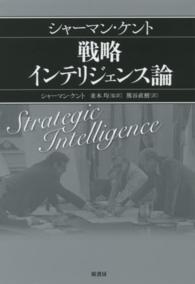- ホーム
- > 洋書
- > 英文書
- > Computer / General
Full Description
CCNA Collaboration CICD 210-060 Official Cert Guide
CCNA Collaboration CICD 210-060 Official Cert Guide from Cisco Press enables you to succeed on the exam the first time and is the only self-study resource approved by Cisco. Long-time Cisco expert and trainer Michael Valentine shares preparation hints and test-taking tips, helping you identify areas of weakness and improve both your conceptual knowledge and hands-on skills.
This complete, official study package includes
A test-preparation routine proven to help you pass the exam
"Do I Know This Already?" quizzes, which enable you to decide how much time you need to spend on each section
Chapter-ending exercises, which help you drill on key concepts you must know thoroughly
The powerful Pearson IT Certification Practice Testsoftware, complete with hundreds of well-reviewed, exam-realistic questions, customization options, and detailed performance reports
A final preparation chapter that guides you through tools and resources to help you craft your review and test-taking strategies
Study plan suggestions and templates to help you organize and optimize your study time
Well regarded for its level of detail, study plans, assessment features, challenging review questions and exercises, this official study guide helps you master the concepts and techniques that ensure your exam success.
CCNA Collaboration CICD 210-060 Official Cert Guide is part of a recommended learning path from Cisco that includes simulation and hands-on training from authorized Cisco Learning Partners and self-study products from Cisco Press. To find out more about instructor-led training, e-learning, and hands-on instruction offered by authorized Cisco Learning Partners worldwide, please visit www.cisco.com.
Michael Valentine, CCNA, CCNP, CCDP, CCVP, CCSI No. 31461, has worked in IT since 1996, and as a trainer since 2001. He is currently a Cisco trainer with Skyline Advanced Technology Services, specializing in Cisco Unified Communications and CCNA. His accessible, humorous, and effective teaching style has demystified Cisco technology for thousands of students. He has developed courseware and labs for both Cisco and its training partners, is co-author of CCNA Exam Cram (Exam 640-802), Third Edition, and is the author of CCNA Voice Quick Reference Guide.
The official study guide helps you master topics on the CCNA Collaboration CICD 210-060 exam, including the following:
Cisco Unified Communications components
Cisco Unified Communications Manager Express administration, end user management, dial plans, and telephony features
Cisco Unified Communications Manager administration, end point management, dial plan elements and interactions, and telephony and mobility features
Cisco Unity Connection voicemail
CM IM and Presence support
CME and CUCM management and troubleshooting
Monitoring Cisco Unity Connection
The CD-ROM contains more than 140 practice questions for the exam, memory table exercises and answer keys, a glossary flash card tool, and a study planner tool.
Pearson IT Certification Practice Test minimum system requirements:
Windows Vista (SP2), Windows 7, Windows 8.1, or Windows 10; Microsoft .NET Framework 4.5 Client; Pentium-class 1 GHz processor (or equivalent); 512 MB RAM; 650 MB disk space plus 50 MB for each downloaded practice exam; access to the Internet to register and download exam databases
This volume is part of the Official Cert Guide series from Cisco Press. Books in this series provide officially developed exam preparation materials that offer assessment, review, and practice to help Cisco Career Certification candidates identify weaknesses, concentrate their study efforts, and enhance their confidence as exam day nears.
Contents
&>
Introduction xxiii
Part I Voice Perspectives
Chapter 1 Traditional Voice Versus Unified Voice 3
"Do I Know This Already?" Quiz 3
Analog Connections 6
Digital Connections 9
Moving from Analog to Digital 9
Channel Associated Signaling 11
Common Channel Signaling 12
Understanding the PSTN 12
Components of the PSTN 12
Understanding PBX and Key Systems 13
Connections To and Within the PSTN 14
PSTN Numbering Plans 15
The Emergence of VoIP 16
VoIP: Why It Is a Big Deal for Businesses 16
The Process of Converting Voice to Packets 17
The Role of Digital Signal Processors 21
Understanding RTP and RTCP 23
Review All the Key Topics 25
Complete the Tables from Memory 25
Definitions of Key Terms 26
Chapter 2 Understanding the Components of Cisco Unified Communications 29
"Do I Know This Already?" Quiz 29
Unified Collaboration 32
Understanding Cisco Unified Communications Manager Express 33
CME Key Features 34
CME Interaction with Cisco IP Phones 35
Understanding Cisco Unified Communications Manager 37
CUCM Key Features 37
CUCM Database Replication and Interacting with Cisco IP Phones 38
Understanding Cisco Unity Connection 41
Cisco Unity Connection Key Features 42
Cisco Unity Connection and CUCM Interaction 43
Understanding Cisco Unified CM IM and Presence 44
Cisco Jabber 45
Understanding Video Communication Server and TelePresence Management Suite 46
Cisco VCS Control and VCS Expressway 46
TelePresence Management Suite 47
Review All the Key Topics 48
Complete the Tables from Memory 48
Definitions of Key Terms 49
Chapter 3 Understanding Cisco IP Phones 51
"Do I Know This Already?" Quiz 51
Connecting and Powering Cisco IP Phones 54
Cisco Catalyst Switch PoE 56
Powering the IP Phone Using a Power Patch Panel or Coupler 56
Powering the IP Phone with a Power Brick 57
VLAN Concepts and Configuration 57
VLAN Review 57
VLAN Trunking/Tagging 58
Understanding Voice VLANs 60
VLAN Configuration 61
Understanding the Cisco IP Phone Boot Process 63
Configuring a Router-Based DHCP Server 64
Setting the Clock of a Cisco Device with NTP 65
IP Phone Registration 67
Quality of Service 68
Understanding the Enemy 69
Requirements for Voice, Video, and Data Traffic 70
Network Requirements for Voice and Video 70
Network Requirements for Data 70
QoS Mechanisms 71
Link Efficiency Mechanisms 72
Queuing Algorithms 73
Applying QoS 74
Using Cisco AutoQoS 74
Review All the Key Topics 82
Complete the Tables from Memory 82
Definitions of Key Terms 83
Part II Cisco Unified Communications Manager Express
Chapter 4 Getting Familiar with CME Administration 85
"Do I Know This Already?" Quiz 85
Preparing the CME Router for Cisco Configuration Professional 88
Managing CME Using CCP 89
CME Integrated GUI 89
Cisco Configuration Professional 90
Review All the Key Topics 94
Complete the Tables from Memory 94
Chapter 5 Managing Endpoints and End Users in CME 97
"Do I Know This Already?" Quiz 97
Describe End Users in CME 100
User Access Levels in CME 100
Creating Users in CME 100
Creating Users with the CME GUI 101
Enabling the CME Built-In GUI 101
Using the CME Built-In GUI to Create the Customer Admin 103
Create or Modify End Users and Endpoints in CME Using the CCP GUI 105
General Capabilities of CCP 105
CCP Unified Communications Configuration 106
Implementing End Users and Endpoints in CME 107
Review All Key Topics 111
Complete the Tables from Memory 111
Define Key Terms 111
Chapter 6 Understanding the CME Dial Plan 113
"Do I Know This Already?" Quiz 113
Configuring Physical Voice Port Characteristics 116
Configuring Analog Voice Ports 116
FXS Ports 116
FXO Ports 119
Configuring Digital Voice Ports 120
Understanding and Configuring Dial Peers 125
Voice Call Legs 126
Configuring POTS Dial Peers 127
Configuring VoIP Dial Peers 131
Using Dial Peer Wildcards 133
Private Line Automatic Ringdown 136
Understanding Router Call Processing and Digit Manipulation 137
Matching Inbound and Outbound Dial Peers 139
Using Digit Manipulation 142
Practical Scenario 1: PSTN Failover Using the prefix Command 143
Practical Scenario 2: Directing Operator Calls to the Receptionist 145
Practical Scenario 3: Specific POTS Lines for Emergency Calls 146
Practical Scenario 4: Using Translation Profiles 148
Using CCP to Configure a CME Dial Plan 151
Understanding and Implementing CME Class of Restriction 153
Using CCP to Implement COR 159
Review All the Key Topics 162
Definitions of Key Terms 163
Chapter 7 Enabling Telephony Features with CME 165
"Do I Know This Already?" Quiz 165
Configuring a Voice Network Directory 168
Configuring Call Forwarding 172
Forwarding Calls from the IP Phone 172
Forwarding Calls from the CLI 172
Using the call-forward pattern Command to Support H.450.3 173
Configuring Call Transfer 175
Configuring Call Park 177
Configuring Call Pickup 182
Configuring Intercom 184
Configuring Paging 187
Configuring After-Hours Call Blocking 191
Configuring CDRs and Call Accounting 194
Configuring Music on Hold 198
Configuring Single Number Reach 199
Configuring Ephone Hunt Groups 201
Final Forwarding Options for Hunt Groups 202
Configuring Night Service Using CCP 203
Configuring Shared Ephone-dn Using CCP 206
Describe Extension Mobility in CME 207
Review All the Key Topics 208
Definitions of Key Terms 208
Part III Cisco Unified Communications Manager
Chapter 8 Administrator and End-User Interfaces 211
"Do I Know This Already?" Quiz 211
Describe the CUCM Administration Interfaces 214
Cisco Unified Communications Manager Administration Interface 214
Cisco Unified Serviceability Administration Interface 215
Cisco Unified Operating System Administration Interface 217
Disaster Recovery System Interface 218
Cisco Unified Reporting Interface 218
CLI 218
User Management in CUCM: Roles and Access Control Groups 219
Roles 219
Access Control Groups 220
Describe the CUC Administration Interfaces 221
Cisco Unity Connection Administration 222
Cisco Unity Connection Serviceability 224
Describe the Cisco Unified CM IM and Presence Server Administration Interfaces 224
Cisco CM-IM and Presence Administration Interface 224
Cisco Unified IM and Presence Serviceability 225
Describe the End-User Interface for CUCM 226
Review All the Key Topics 228
Definitions of Key Terms 228
Chapter 9 Managing Endpoints and End Users in CUCM 231
"Do I Know This Already?" Quiz 231
Implementing IP Phones in CUCM 234
Special Functions and Services Used by IP Phones 234
NTP 234
CDP 235
DHCP 235
PoE 235
TFTP 235
DNS 235
IP Phone Registration Process 236
SIP Phone Registration Process 236
Preparing CUCM to Support Phones 237
Service Activation 237
DHCP Server Configuration 237
Configuring DHCP in Router IOS 239
IP Phone Configuration Requirements in CUCM 240
Device Pool 240
Device Defaults 242
Softkey Template and Phone Button Template 242
Profiles 242
Adding Phones in CUCM 243
Manual Configuration of IP Phones 243
Auto-Registration of IP Phones 247
Bulk Administration Tool 250
Auto Register Phone Tool 251
Self-Provisioning 252
Describe End Users in CUCM 252
End Users Versus Application Users 252
Credential Policy 253
Features Interacting with User Accounts 253
User Locale 254
Device Association 254
Implementing End Users in CUCM 255
Manual Entry 255
Bulk Import Using BAT 256
LDAP Integration 256
LDAP Synchronization 256
LDAP Authentication 257
LDAP Integration Considerations 257
LDAP Sync Agreements 259
LDAP Sync Mechanism 260
LDAP Custom Filters 260
Configure LDAP Sync 260
Activate DirSync 260
Configure the LDAP System 260
Configure the LDAP Directory 261
Verify LDAP Sync 262
Configuring LDAP Authentication 262
Verify LDAP Authentication 263
Create LDAP Custom Filters 263
Review All the Key Topics 264
Definitions of Key Terms 264
Chapter 10 Understanding CUCM Dial Plan Elements and Interactions 267
"Do I Know This Already?" Quiz 267
CUCM Call Flows 270
Call Flow in CUCM If DNS Is Used 270
Call Flow in CUCM If DNS Is Not Used 271
Centralized Remote Branch Call Flow 273
Centralized Deployment PSTN Backup Call Flow 274
Centralized Deployment Considerations and Limitations 275
PSTN Backup Using CAC 275
Distributed Deployment Call Flow 276
Call Routing Sources in CUCM 277
Call Routing Destinations in CUCM 277
Call Routing Configuration Elements 278
Route Pattern 278
Route List 279
Route Group 279
Gateways and Trunks 280
Call Routing Behavior 280
Digit Analysis 280
Hunt Groups 281
Class of Control 282
Partition 282
Calling Search Space 282
Interaction of Partitions and Calling Search Spaces 282
Line Device Configuration 283
Review All the Key Topics 284
Definitions of Key Terms 284
Chapter 11 Enabling Telephony and Mobility Features with CUCM 287
"Do I Know This Already?" Quiz 287
Describe Extension Mobility in CUCM 290
Enable EM in CUCM 291
Describe Telephony Features in CUCM 298
Call Coverage 298
Call Forward 298
Shared Lines 299
Barge and Privacy 299
Call Pickup 300
Call Hunting 300
Call Park 301
Intercom 301
CUCM Native Presence 301
Presence Architecture 302
Enable Telephony Features in CUCM 303
Enabling Call Coverage 303
Configuring Shared Lines 303
Configuring Barge 304
Configuring Call Pickup 305
Configuring Call Park and Directed Call Park 308
Configuring Call Hunting 310
Configuring Intercom Features 313
Configure CUCM Native Presence 315
Configuring BLF Speed Dials 315
Configuring Presence-Enabled Call Lists 316
Configuring Custom Presence Groups 317
Review All the Key Topics 321
Definitions of Key Terms 321
Chapter 12 Enabling Mobility Features in CUCM 323
"Do I Know This Already?" Quiz 323
Understanding CUCM Mobility Features 326
Describe Mobile Connect 326
Unified Mobility Architecture 327
Access Lists 327
Time-of-Day Access 327
Mobile Voice Access 328
Implementing Mobility Features in CUCM 328
Configuring Mobile Connect 329
Step 1: Configure Softkey Templates 329
Step 2: Configure User Accounts for Mobility 329
Step 3: Configure the IP Phone to Support Mobility Features 331
Step 4: Create Remote Destination Profiles 331
Step 5: Add Remote Destinations to Remote Destination Profiles 331
Step 6: Configure Ring Schedules for Each Remote Destination 332
Step 7: Configure Access Lists 333
Step 8: Apply Access Lists 334
Step 9: Configure Service Parameters 335
Configuring MVA 336
Step 1: Activate the MVA Service 337
Step 2: Configure Service Parameters 337
Step 3: Enable MVA for Each User 338
Step 4: Configure the MVA Media Resource 339
Step 5: Configure the MVA VXML Application at the IOS Gateway 340
Review All the Key Topics 341
Definitions of Key Terms 341
Part IV Voicemail and Presence Solutions
Chapter 13 Voice Messaging Integration with Cisco Unity Connection 343
"Do I Know This Already?" Quiz 343
Describe Cisco Unity Connection 346
Overview of Cisco Unity Connection 346
Single-Site and Multisite Deployment Considerations 346
CUC Integration Overview 347
CUC Integration with CUCM Using SCCP 347
CUC Integration Using SIP 348
CUC Features 349
System Settings 349
Enterprise Parameters and Service Parameters 350
LDAP 350
Call Handlers 350
Call Routing 351
Direct Routing Rules 351
Forwarded Routing Rules 352
Call Routing Rule Filters 352
Distribution Lists 352
Authentication Rules 352
Dial Plan 353
Describe Cisco Unity Connection Users and Mailboxes 353
User Templates 353
User Template Basics 353
Password Settings 354
Roles 354
Transfer Rules and Greetings 354
Call Actions 355
Message Settings, Message Actions, and Caller Input 355
TUI Settings 355
CUC End Users 355
Extension and Call Forward Options 356
Voice Messaging with SRST and AAR 356
Voicemail Box 356
Private Distribution Lists 356
Notification Devices 356
User Creation Options 356
CUC Voicemail Boxes 357
Message Aging Policy and Mailbox Quotas 357
Implement Cisco Unity Connection Users and Mailboxes 357
Configure End User Templates 357
User Template Basics 358
Password Settings 359
Roles 360
Message Settings 360
Message Actions 361
Phone Menu 362
Playback Message Settings 363
Notification Devices 364
Configure CUC End Users 365
Manual Process 365
Alternate Extensions and Names 366
Private DLs 367
Importing End Users into CUC 368
Importing Users from CUCM 368
Importing Users from LDAP 370
Bulk Administration Import of CUC Users 372
Managing the CUC Message Store 373
Mailbox Stores Membership 374
Message Aging Policy 374
Mailbox Quotas 375
Review All the Key Topics 377
Definitions of Key Terms 377
Chapter 14 Enabling CM IM and Presence Support 379
"Do I Know This Already?" Quiz 379
Describe CM-IMP Features 381
Jabber 381
Jabber Operating Modes 381
Enterprise Instant Messaging 382
Voice Calls 383
Video Calls 383
Integration Support 383
Cisco Unified Client Services Framework 383
Cisco Unified Communications Manager IP Phone Service 384
Describe Cisco Unified Presence Architecture 384
Integration with Microsoft Office Communications Server 385
Integration with LDAP 385
Integration with Cisco Unity Connection 385
Integration with Conferencing Resources 386
Integration with Calendar Resources 386
Architecture and Call Flow: Softphone Mode 386
Architecture and Call Flow: Deskphone Control Mode 386
IM/Chat, Compliance, and Persistent Chat 387
CM-IMP and QoS Considerations 387
Enabling CM-IMP 389
Enabling End Users for Cisco Jabber in CUCM 389
Step 1: Configure End Users in CUCM 389
Step 2: Associate the Directory Numbers with the End Users in CUCM 390
Step 3: Create a Cisco Unified CSF Device 390
Step 4: Associate the CSF Device with the End User in CUCM 390
Enabling End Users for Jabber in CUCM 390
Enabling CUCM Presence Signaling Integration with CM-IMP 393
Enabling End Users for Jabber in CM-IMP 394
Troubleshooting Jabber 394
Review All the Key Topics 396
Definitions of Key Terms 396
Part V Voice Network Management and Troubleshooting
Chapter 15 Common CME Management and Troubleshooting Issues 399
"Do I Know This Already?" Quiz 399
Troubleshooting 402
Troubleshooting Common CME Registration Issues 403
Issue 1: Verifying PoE 405
Issue 2: Voice VLAN Assignment 405
Issue 3: DHCP Server 406
Issue 4: TFTP Server 406
Issue 5: CME Server 407
Troubleshooting Dial Plan and QoS Issues 407
Dial Plan Issues 407
QoS Issues 410
Review All the Key Topics 414
Definitions of Key Terms 414
Chapter 16 CUCM Monitoring, Maintenance, and Troubleshooting 417
"Do I Know This Already?" Quiz 417
Describe How to Provide End-User Support for Connectivity and Voice
Quality Issues 421
Troubleshooting 421
Troubleshooting IP Phone Registration Problems 422
Deleting Unassigned Directory Numbers Using the Route Plan Report 424
Describe CUCM Reports and How They Are Generated 425
Generating Reports 425
Analyzing Reports 427
Understanding CUCM CDR Analysis and Reporting Tool Reports 427
Activate CAR-Related Services 428
Configure CDR Service Parameters 428
CAR Tool Users 429
CDR and CMR Architecture 429
CAR System Parameters 429
Exporting CDR and CMR Records 430
Generating CDR Reports 430
Report Generation Example 431
Generating System Reports 433
Generating Device Reports 434
Describe Cisco Unified RTMT 434
RTMT Interface 436
Monitoring CUCM with RTMT 436
Voice and Video Summary 437
Gateway Activity 437
Device Search 438
Database Summary 439
Call Activity 440
Alert Central 442
Remote Browse 443
Syslog 443
Describe the Disaster Recovery System 444
Using the DRS 445
Set Up a Backup Device 445
Create a Scheduled Backup 445
Perform a Restore 446
Review All the Key Topics 447
Definitions of Key Terms 447
Chapter 17 Monitoring Cisco Unity Connection 449
"Do I Know This Already?" Quiz 449
Generating and Accessing Cisco Unity Connection Reports 452
Cisco Unity Connection Serviceability Reports 452
Cisco Unified Serviceability: Serviceability Reports Archive 455
Analyzing Cisco Unity Connection Reports 457
Troubleshooting and Maintenance Operations Using Cisco Unity Connection Reports 459
Reports to Support Routine Maintenance 462
Review All the Key Topics 465
Definitions of Key Terms 465
Chapter 18 Final Preparation 467
Tools for Final Preparation 467
Exam Engine and Questions on the CD 467
Install the Exam Engine 467
Activate and Download the Practice Exam 468
Activating Other Exams 468
Premium Edition 468
The Cisco Learning Network 469
Memory Tables 469
Chapter-Ending Review Tools 469
Study Plan 469
Recall the Facts 470
Practice Configurations 470
Using the Exam Engine 470
Part VI Appendixes
Appendix A Answers Appendix 473
Appendix B Exam Updates 477
Always Get the Latest at the Companion Website 477
Technical Content 477
Appendix C Managing CME Using the Command Line 479
Glossary 493
Index 507
CD-Only Appendixes
Appendix D Memory Tables
Appendix E Memory Table Answer Key
Appendix F Study Planner








